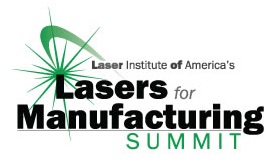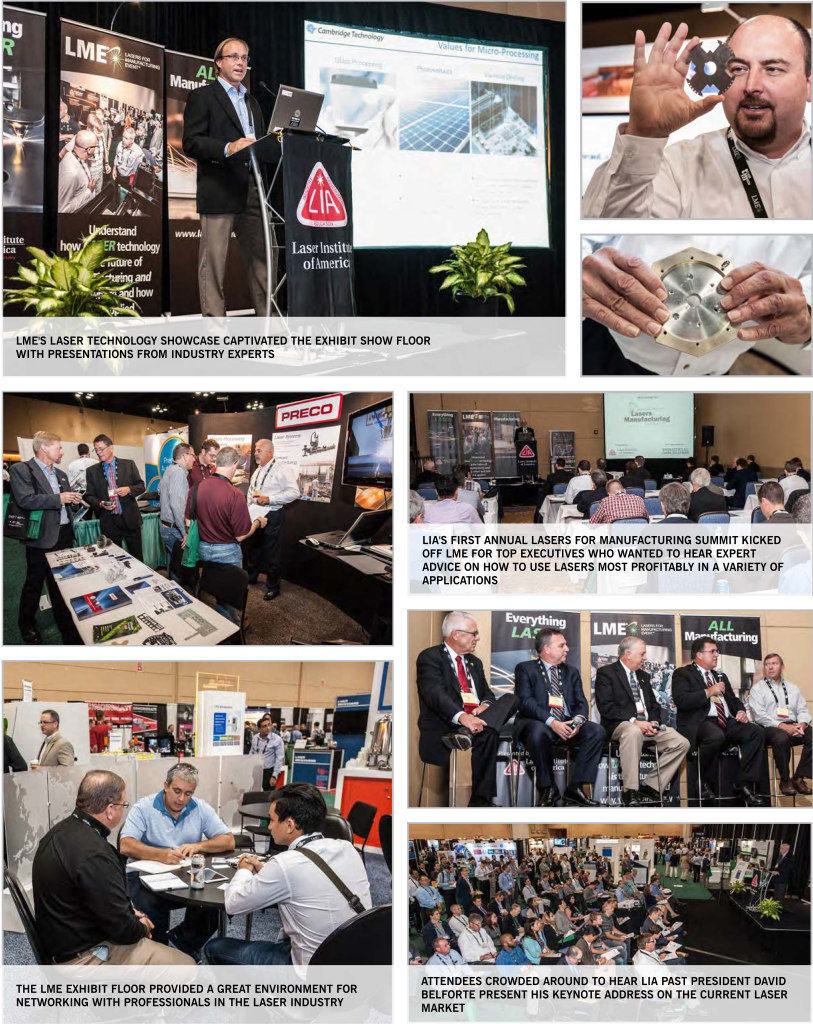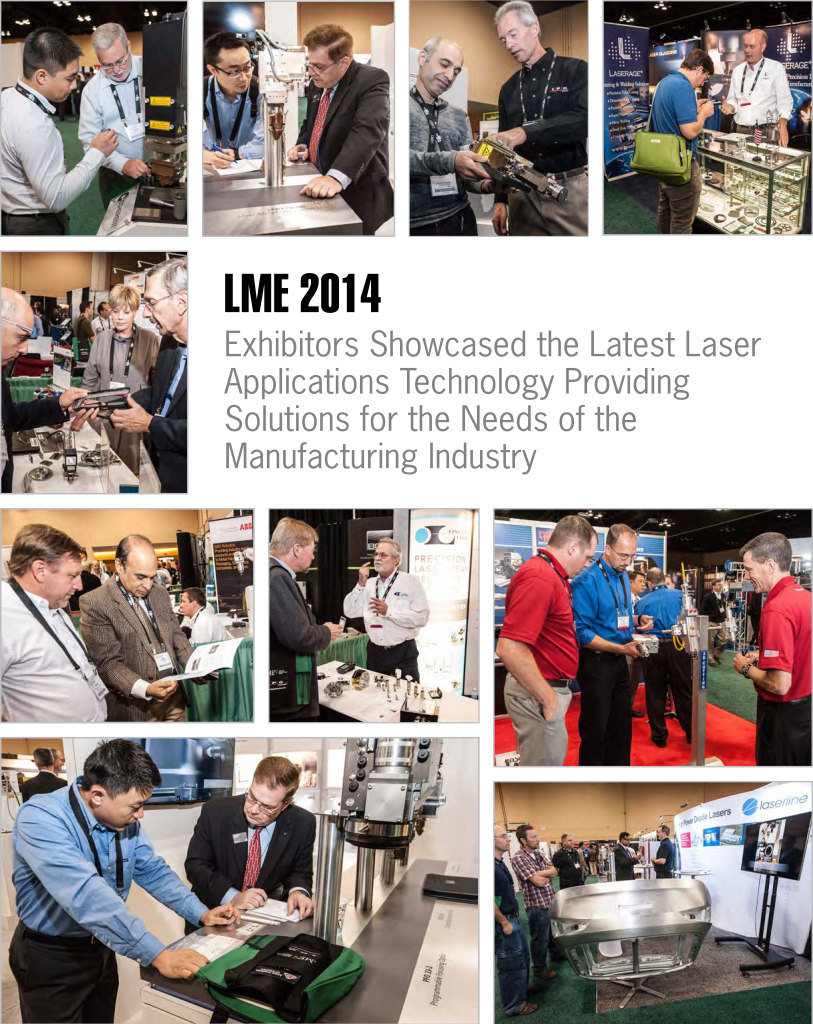By Geoff Giordano
Sapphire cutting for electronic displays, laser marking and processes related to retrieving and transporting oil, were among the leading applications spotlighted at LIA’s fourth Lasers for Manufacturing Event® (LME®) on Sept. 23-24 at the Schaumburg (IL) Convention Center.
Attendees packed 101-level courses on laser types, laser welding, cost advantages of lasers and laser safety, as well as four keynote addresses at the Laser Technology Showcase Theater in the exhibit hall. Nine working laser systems added to the attraction, as did a new tour of exhibits by Ask the Experts booth chair Rob Mueller.
 This year, LIA’s first Lasers for Manufacturing Summit, the day before LME, painted a broader picture of global opportunities for laser processes. In addition to providing vital statistics on established and often-disappointing emerging markets, the summit offered a fast-paced panel discussion and spirited question-and-answer period providing the kind of insider perspective attendees craved. Five expert panelists tackled questions about the future of feedback control in micromachining, diode lasers directly coupled to fibers, technology that might replace solid-state fiber lasers, and what will become of CO2 lasers.
This year, LIA’s first Lasers for Manufacturing Summit, the day before LME, painted a broader picture of global opportunities for laser processes. In addition to providing vital statistics on established and often-disappointing emerging markets, the summit offered a fast-paced panel discussion and spirited question-and-answer period providing the kind of insider perspective attendees craved. Five expert panelists tackled questions about the future of feedback control in micromachining, diode lasers directly coupled to fibers, technology that might replace solid-state fiber lasers, and what will become of CO2 lasers.
Another summit Q&A topic was the shortage of skilled labor to tackle 21st century manufacturing demands. Workforce-building efforts to increase the talent pool of laser technicians and process engineers were discussed, including programs at OP-TEC in Texas, LASER-TEC in Florida and the new Midwest Photonics Education Center at Indian Hills Community College in Ottumwa, IA.
Exhibitors displayed products ranging from new lasers to eye protection. Newcomer Gravotech of Duluth, GA, brought CO2 and fiber gantry lasers, a 50 W galvo-steered fiber laser and a 3 W green laser.
“The people we have talked to have had real interest in projects,” said Andrew Wellons, manager of industrial sales for Gravotech. “Obviously (LME) is laser-focused, so expect to be talking to people who are very well-versed in and focused on lasers.” All the lasers they brought are for marking — an area of opportunity frequently addressed at LME. “There was some downturn a few years back, but it’s been coming on pretty strong. (There are) a lot of new competitors… a lot of very small companies.”
Coherent noted via Facebook that they brought “our next-generation picosecond laser, our new CO2 laser platform, and our direct diode laser series.” During Coherent’s Showcase Theater presentation, strategic marketing director Magnus Bengtsson discussed the company’s revamped midpower (150 to 400 W) CO2 line and noted that CO2 lasers “continue to be workhorses, and there’s definitely innovation still to be made.” During the summit Q&A, panelist Stan Ream noted that when he joined EWI, they still had a 6 kW CO2 laser: “It didn’t get much work, so we sold it — and now I wish I had it back. There are things you can do with that wavelength that are just better than you can do with some of the shorter wavelengths,” for example with polymers and other nonmetals.
In terms of process monitoring and product tracking, several new or recently introduced devices drew attention. First-time exhibitor Innovar Systems Limited of North Jackson, OH, showcased its new Enforcer Total Traceability Controller, while Germany’s Precitec unveiled its In-Process Depth Meter and Macken Instruments of Santa Rosa, CA, showed an upgraded product to monitor beam shape.
Making Sense of Markets
In opening the summit, LIA Executive Director Peter Baker noted that it was conceived to give executives “a perspective on the world of lasers in manufacturing, to show you the market, the players, the technology and the opportunity.”
Kickoff speaker Mark Douglass of Longbow Research illustrated a challenging world economy in which the US remains “the best house in a lousy neighborhood.” Douglass, formerly a laser researcher and engineer turned analyst, pointed to sluggish global economic growth in 2014 and 2015. Providing snapshots of industrial markets relevant to lasers, he asserted that Brazil has been “very disappointing” despite World Cup and Olympics hype and government stimulus. Argentina and Venezuela are “basket cases,” and “we’re still waiting for India to grow.” China is “somewhat better, but there are still lingering issues with banks and real estate as they transition their economy.” Europe in 2013 was “weaker than anticipated but seems to be stable.”
Turning his attention more to the US, Douglass noted that reshoring of manufacturing is real, “but it’s not a panacea.” The downturn of 2009 made manufacturers realize short supply chains are most desirable during an economic shock, he explained. Quality issues and labor and transportation costs are contributing to the effect. However, “reshoring might be hard to see; US production levels have been growing nicely, but employment continues to shrink. …We’re at roughly 30 percent of (manufacturing) jobs we had before the big recession — but we’re already at the same levels of output.”
Nevertheless, Douglass said, appliance and automotive manufacturers are adding capacity in North America — often in Mexico. For 2014-15, he expects most industrial markets to improve modestly. “Machine-tool demand we think recovers; mining hopefully finds the bottom in 2015; automotive and truck production rates are still great, but they’re likely peaking.” Rail car production should continue to grow as they are needed to move oil produced by fracking — and pipeline construction should also remain healthy.
“Rail car production has been off the charts,” Douglass asserted, “and now because of safety concerns, old cars have to be retrofitted; there’s a lot of opportunity in heavy metal fabrication.” Related infrastructure needs provide yet more opportunity. Other US industries Douglass highlighted include:
- Machine tools: 2015 might see an uplift after “a soft couple of years.”
- Farm equipment: Demand might fall by double digits as farmers who have been spending on equipment the past few years earn less from crops while commodity prices fall.
- Construction equipment: Experienced the massive reduction in production that looms for agriculture but improved moderately in the first half of 2014.
- Heavy trucks: Good momentum the past couple of years and a good sector to be in.
- Automotive: “Really nice recovery in North American production,” with pent-up demand pushing equipment sales.
- Aircraft: Production modest in 2014 but improving.
Echoing those themes in his traditional LME keynote address, LIA Past President David Belforte noted that “industrial lasers for materials processing represent 11 percent of all machine-tool sales globally. We’re no longer a curiosity. However, it’s still a weak global economy for manufacturing.”
Amid the highlights of Belforte’s midyear analysis:
- Global revenues from laser sales should increase by 5 percent by the end of 2014, “courtesy of the 21 percent that the fiber laser industry has contributed.” Fiber laser sales are likely to approach the $1 billion level, representing about 38 percent penetration into the total laser marketplace.
- Fiber lasers are slow to penetrate in Japan, where CO2 and solid-state units dominate. “Japanese job shops that buy laser cutting machines think by virtue of past experience that CO2 lasers give them the most flexibility in terms of processing a variety of materials in their plants.” East Asia and Japan represented 47 percent of the $11 billion worth of industrial laser systems installed in 2013.
- In macro applications (lasers greater than 1 kW output power), CO2 lasers remain dominant as fiber lasers catch up; in micro applications (lasers less than 1 kW output power), solid-state lasers are strong.
- Energy and aerospace remain hot areas of opportunity in North America.
- Smart phones require about 15 laser functions. “Sapphire cover glass looks like the wave of the future, and if you look at the patents… all of them include laser cutting.”
- Metal stents appear to be losing favor vs. nonmetal versions, which might change or diminish laser use in that sector.
Array of Applications
Additive/3D processes figured heavily throughout LME, from summit presentations by Terry Wohlers on the state of the industry and James Yang’s overview of additive manufacturing at GE to Paul Denney’s tutorial on laser additive manufacturing systems and Tim Biermann’s Showcase Theater keynote.
Denney, of Lincoln Electric, gave an overview of the converging technologies at the foundation of the revolution in 3D printing and what he calls 2D-plus. Laser hot-wire cladding presents a growth opportunity when compared with powder processes, he noted. By his estimation, cladding material with powder can cost about $35.70 a pound vs. $15.95 with preheated wire. Preventing or repairing corrosion on equipment used to retrieve oil from increasingly inhospitable environments can be a significant driver of laser-related revenue, he demonstrated.
“If I have a 6 inch diameter pipe and I put 3 mm buildup on it and it’s a kilometer long, it’s about 40 kg per meter of pipe. If you extrapolate out for a kilometer, it’s 40,000 kg (of material), and I’m putting it down at about a kilogram an hour. We’re talking about the tsunami that’s being created by GE’s request for 35,000 (additively manufactured) parts a year; think about the tsunami we’re creating to clad pipe.”
Meanwhile, Biermann, of Fraunhofer ILT, discussed powder-bed and powder-fed additive processes and the importance of optimizing every step of their vertical and horizontal process chains. Noting that a metal powder-fed system might cost about 200,000 to 1.5 million Euros and a powder-bed system 250,000 to 1 million Euros, he cautioned attendees from smaller companies to “get your math done” before diving into AM. Not doing so, he warned, could result in a failed project and potentially hinder broader acceptance of AM by creating the perception of low ROI.
For diode laser maker Laserline, the tipping point for job shops to embrace additive processes could be around the second quarter of 2015, said Wolfgang Todt, vice president of US operations. That’s when “the accounts we’re talking to are going into full production with their machines,” he noted. “Job shops overall are busy like crazy, and the ones we’re dealing with are all looking for more lasers. A lot of the end users buying from job shops are looking into getting their own lasers.”
Wohlers said AM hype really took off around the third quarter of 2012. Now, “we think there are between 400 and 700 startup companies” on the low-cost side of AM. High-end applications in aerospace, medicine and dentistry contributed to the surge in interest; he noted that Boeing uses tens of thousands of polymer AM parts, while Airbus claims it will be using hundreds of AM machines to produce its parts — many of metal — within five years.
Revenues from sales of metal AM machines grew by almost 76 percent last year, Wohlers said — and most are laser-based. But in addressing the myths surrounding AM — that you can make “anything” additively, that AM is fast and just as inexpensive when building one part at a time — he concluded that AM will not replace conventional manufacturing. “There’s a lot of stuff that’s not yet a fit. Will it ever be? In some cases, yes.” But the hype is understandable when, for example, NASA takes a 115-part rocket nozzle and consolidates it into two digitally printed components.
Beyond additive, other application highlights included:
- In his tutorial on high-power laser welding, David Havrilla of TRUMPF illustrated the benefits of partial vs. full penetration, butt vs. overlap joints, special cuts and bends in tubing and how designing for laser welding can increase vehicle accessibility and driver visibility by reducing or eliminating flange width. Using the Volkswagen Golf as an example, he detailed how the Golf V featured 70 meters of laser welding, resulting in 80 percent more static torsion stiffness, 15 percent more dynamical torsion stiffness, and 35 percent more dynamical bending stiffness vs. the Golf IV, which featured only 1.4 meters of laser welds. Miyachi America’s Geoff Shannon provided a broader overview on laser welding.
- SPI Laser’s Ken Dzurko illustrated how to adjust a single laser for multiple uses — cutting, marking, engraving and texturing.
- Ultrafast processes were covered by TRUMPF’s Sascha Weiler and Ronald Schaeffer of PhotoMachining in Pelham, NH, while TRUMPF’s Patrick Grace delved into system costs. In detailing optimal parameters for using pico- and femtosecond systems, Schaeffer compared per-watt costs of nano-, pico- and femtosecond lasers.
All in all, LME again delivered as a laser-only showcase packed with advanced manufacturing applications and opportunities to network with the key industry players.
“Overall I was impressed,” said Bystronic product specialist Mitchell Van Zuiden, who gave a keynote address on laser cutting applications. “I was surprised by the number of exhibitors as well as the number of attendees. The Showcase Theater seemed to be very popular… there seemed to be a lot of interest. I am encouraging my superiors to consider exhibiting at this event next year.”
And for Brian Olsen, who is trying to break into the laser business through a program at the College of Lake County in Grayslake, IL, “I’m trying to find out as much as I can.” He found LME’s welding instruction useful “because it took a theory and applied it.”
Follow updates for the upcoming LME at www.laserevent.org.









